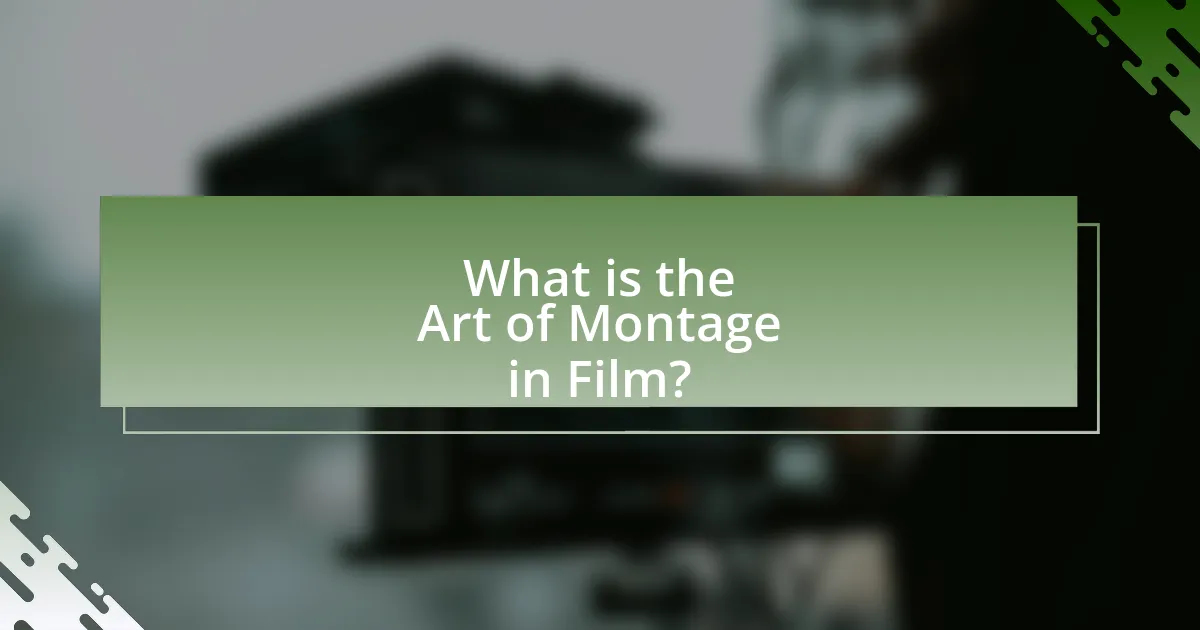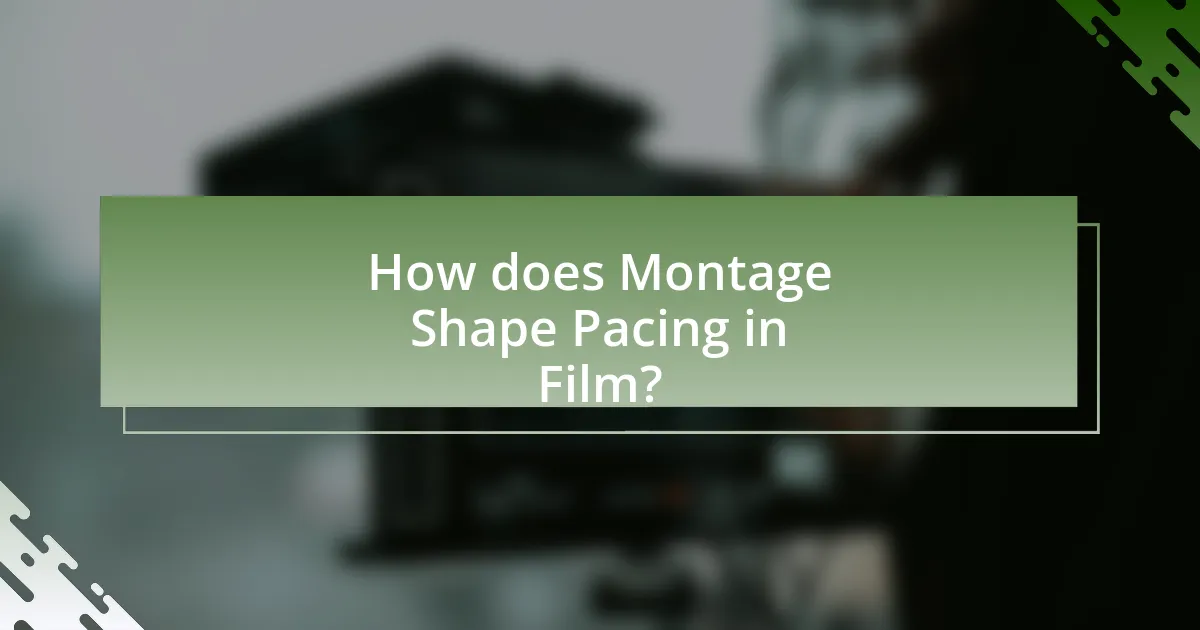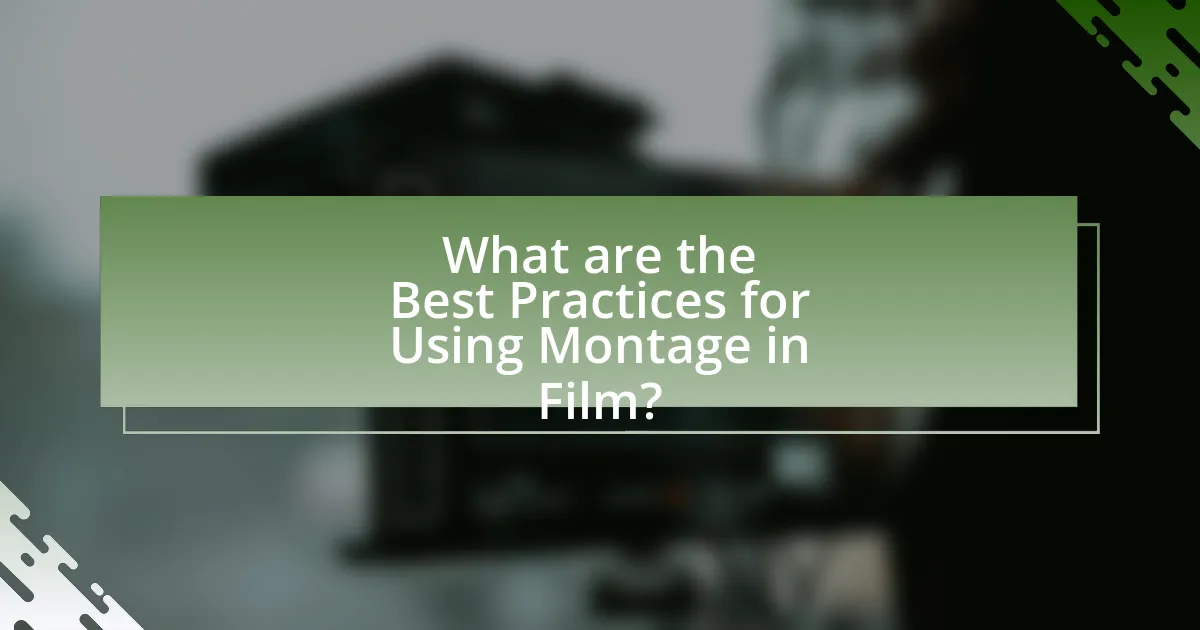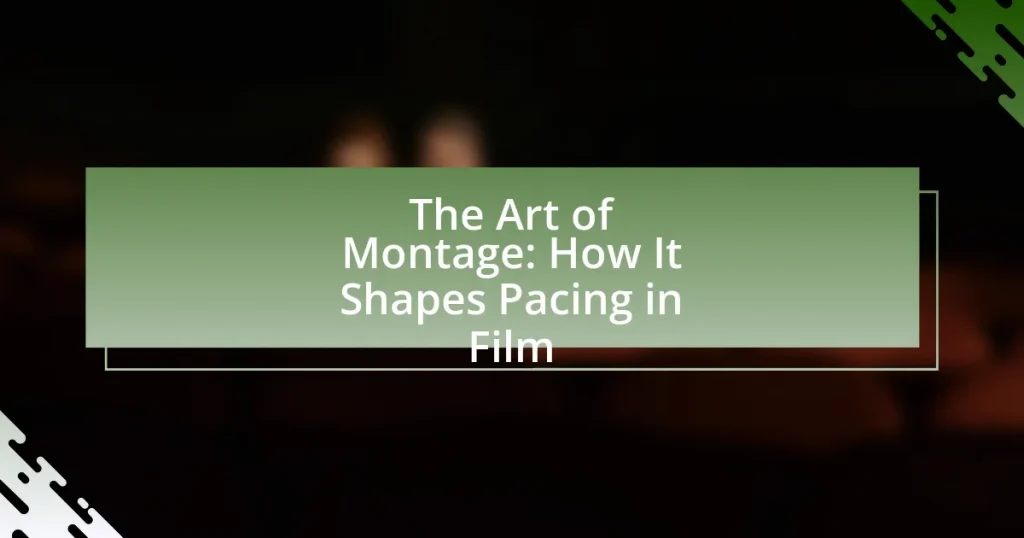The Art of Montage in film is a crucial editing technique that combines a series of shots to create a cohesive narrative and emotional impact. This article explores how montage influences storytelling by condensing time and enhancing emotional engagement, highlighting various techniques such as analytical, thematic, and rhythmic montage. It also examines the historical context of montage, key figures in its development, and its role in shaping pacing and audience perception across different film genres. Additionally, best practices for effective montage implementation and resources for further learning are discussed, providing a comprehensive understanding of how montage shapes the cinematic experience.

What is the Art of Montage in Film?
The Art of Montage in film refers to the technique of editing together a series of shots to create a cohesive narrative or emotional effect. This method allows filmmakers to convey complex ideas, emotions, or themes by juxtaposing different images and sounds, thereby influencing the pacing and rhythm of the film. Historically, montage has been pivotal in cinema, with early examples seen in the works of filmmakers like Sergei Eisenstein, who utilized it to evoke emotional responses and highlight contrasts, such as in his film “Battleship Potemkin.” This editing style not only shapes the viewer’s experience but also enhances storytelling by compressing time and space, making it a fundamental aspect of film language.
How does montage influence storytelling in cinema?
Montage significantly influences storytelling in cinema by creating a narrative structure that condenses time and enhances emotional impact. Through the juxtaposition of images, filmmakers can convey complex ideas and emotions quickly, allowing audiences to grasp the essence of a story without lengthy exposition. For instance, Sergei Eisenstein’s theory of montage emphasizes the collision of shots to generate meaning, as seen in his film “Battleship Potemkin,” where the famous Odessa Steps sequence uses rapid cuts to evoke a sense of chaos and urgency. This technique not only accelerates the pacing of the film but also deepens the viewer’s engagement with the characters and themes, demonstrating how montage serves as a powerful tool for storytelling in cinema.
What are the different types of montage techniques?
The different types of montage techniques include analytical montage, thematic montage, and rhythmic montage. Analytical montage breaks down a scene into its components to convey information efficiently, often used in documentaries and educational films. Thematic montage juxtaposes images to create a narrative or emotional connection, commonly seen in music videos and art films. Rhythmic montage focuses on the pacing and timing of shots to evoke specific feelings or reactions, frequently utilized in action sequences and experimental cinema. Each technique serves distinct purposes in shaping the storytelling and pacing of a film.
How do these techniques affect audience perception?
Montage techniques significantly influence audience perception by manipulating time, emotion, and narrative structure. These techniques create a rhythm that guides viewers’ emotional responses and understanding of the story. For instance, rapid cuts can generate excitement or tension, while slower transitions may evoke contemplation or sadness. Research by David Bordwell in “Narration in the Fiction Film” highlights that the arrangement of shots affects how viewers interpret relationships and events, demonstrating that montage shapes not only pacing but also the emotional journey of the audience.
Why is pacing important in film editing?
Pacing is crucial in film editing because it directly influences the emotional rhythm and narrative flow of a film. Effective pacing ensures that scenes transition smoothly, maintaining audience engagement and enhancing storytelling. For instance, a study by the University of Southern California found that films with well-structured pacing can increase viewer retention and emotional response, demonstrating that pacing is not merely a technical aspect but a fundamental element that shapes the viewer’s experience.
What role does montage play in establishing pacing?
Montage plays a crucial role in establishing pacing by manipulating the rhythm and tempo of a film’s narrative. Through the selection and arrangement of shots, montage can accelerate or decelerate the flow of the story, creating tension or relaxation as needed. For example, rapid cuts in a montage sequence can heighten excitement and urgency, while longer, more contemplative shots can slow down the narrative, allowing for reflection. This technique has been effectively utilized in films such as “Rocky,” where training montages convey the passage of time and the protagonist’s development, thereby influencing the audience’s emotional engagement with the story.
How can pacing impact the emotional response of viewers?
Pacing significantly impacts the emotional response of viewers by controlling the rhythm and flow of a narrative. When pacing is fast, it can create feelings of excitement or tension, as seen in action sequences where quick cuts heighten adrenaline. Conversely, slower pacing allows for reflection and emotional depth, often used in dramatic scenes to evoke empathy and contemplation. Research by the University of Southern California indicates that variations in pacing can manipulate viewer engagement and emotional investment, demonstrating that effective pacing is crucial for eliciting desired emotional reactions in film.
What historical context surrounds the use of montage?
The historical context surrounding the use of montage is rooted in early 20th-century cinema, particularly influenced by Soviet filmmakers like Sergei Eisenstein. Eisenstein developed the concept of montage as a technique to create emotional and intellectual responses through the juxtaposition of images, which he articulated in his 1925 film “Battleship Potemkin.” This approach emerged during a period of rapid technological advancement and political upheaval, where filmmakers sought innovative methods to convey complex narratives and ideologies. The Russian Revolution of 1917 further propelled the use of montage as a means of propaganda, emphasizing the power of editing to manipulate audience perception and evoke specific reactions.
Who are the key figures in the development of montage theory?
The key figures in the development of montage theory are Sergei Eisenstein, Lev Kuleshov, and Dziga Vertov. Sergei Eisenstein is renowned for his work on the intellectual montage, which emphasizes the juxtaposition of images to create meaning, as demonstrated in his films like “Battleship Potemkin.” Lev Kuleshov contributed to the theory with the Kuleshov Effect, illustrating how viewers derive meaning from the sequence of shots rather than the individual images. Dziga Vertov advanced the concept of montage through his documentary work, particularly in “Man with a Movie Camera,” where he showcased the potential of editing to convey reality and emotion. These figures collectively shaped the understanding and application of montage in film, influencing cinematic storytelling techniques.
What films exemplify the evolution of montage techniques?
“Battleship Potemkin,” directed by Sergei Eisenstein, exemplifies the evolution of montage techniques through its innovative use of rhythmic editing and juxtaposition to create emotional impact. Eisenstein’s work in this 1925 film introduced the concept of intellectual montage, where contrasting images are combined to provoke thought and convey complex ideas, as seen in the famous Odessa Steps sequence. Another significant film is “Psycho,” directed by Alfred Hitchcock, which utilized rapid cuts and cross-cutting to heighten tension and suspense, particularly in the shower scene. This technique influenced the thriller genre and showcased how montage could manipulate audience emotions effectively. Additionally, “The Godfather,” directed by Francis Ford Coppola, employed parallel editing to interweave multiple storylines, demonstrating how montage can enhance narrative complexity and pacing. These films collectively illustrate the transformative power of montage in shaping cinematic storytelling and audience engagement.
How does montage connect to the overall film structure?
Montage connects to the overall film structure by serving as a crucial technique that organizes and condenses time, enhancing narrative flow and emotional impact. This editing method allows filmmakers to juxtapose different scenes, creating meaning through the relationship between images, which can accelerate pacing or build tension. For instance, in Sergei Eisenstein’s films, such as “Battleship Potemkin,” the use of montage not only conveys complex ideas but also shapes the viewer’s emotional response, demonstrating how editing can manipulate time and space within the film’s structure.
What are the common challenges filmmakers face with montage?
Filmmakers commonly face challenges with montage, including maintaining narrative coherence, achieving emotional impact, and managing pacing. Narrative coherence is crucial, as disjointed sequences can confuse viewers; for instance, a poorly executed montage may disrupt the story flow, leading to audience disengagement. Achieving emotional impact is another challenge, as filmmakers must select images and sounds that resonate with the intended feelings; research indicates that effective montages can evoke strong emotions, but misalignment can result in a lack of connection. Lastly, managing pacing is essential; montages must balance speed and rhythm to enhance storytelling without overwhelming the audience, as evidenced by studies showing that well-paced montages can significantly improve viewer retention and engagement.

How does Montage Shape Pacing in Film?
Montage shapes pacing in film by manipulating the arrangement and duration of shots to create rhythm and emotional impact. This technique allows filmmakers to control the flow of time and the viewer’s perception of events, often speeding up or slowing down the narrative pace. For instance, in Sergei Eisenstein’s “Battleship Potemkin,” rapid cuts during the Odessa Steps sequence heighten tension and urgency, demonstrating how montage can accelerate pacing to evoke strong emotional responses.
What specific techniques are used to manipulate pacing through montage?
Specific techniques used to manipulate pacing through montage include rapid cuts, cross-cutting, and the use of rhythmic editing. Rapid cuts create a sense of urgency and speed by shortening the duration of shots, which can heighten tension or excitement. Cross-cutting alternates between two or more scenes occurring simultaneously, allowing for a dynamic interplay that can accelerate the narrative pace. Rhythmic editing involves aligning the cuts with the beat of music or sound, enhancing the emotional impact and driving the pacing forward. These techniques are widely recognized in film studies, as evidenced by their application in various cinematic works, demonstrating their effectiveness in shaping viewer perception and engagement.
How does rhythm in editing affect the flow of a scene?
Rhythm in editing significantly influences the flow of a scene by controlling the pacing and emotional impact of the narrative. A well-established rhythm can create tension, enhance drama, or facilitate a smoother transition between moments, thereby guiding the audience’s emotional response. For instance, rapid cuts can generate excitement or urgency, while longer takes may evoke contemplation or sadness. Studies in film theory, such as those by Sergei Eisenstein, demonstrate that the juxtaposition of shots can manipulate viewer perception and engagement, reinforcing the idea that rhythm is a crucial element in shaping how a scene is experienced.
What is the impact of shot duration on pacing?
Shot duration significantly impacts pacing by influencing the rhythm and flow of a film. Shorter shot durations typically create a faster pace, generating excitement and urgency, while longer shot durations allow for more contemplation and emotional depth, resulting in a slower pace. Research indicates that films with rapid editing, such as action genres, often utilize shorter shots to maintain viewer engagement, whereas dramas may employ longer shots to develop character and narrative complexity. This relationship between shot duration and pacing is crucial in shaping audience perception and emotional response throughout the film.
How do different genres utilize montage for pacing?
Different genres utilize montage for pacing by employing specific editing techniques that align with their narrative goals. For instance, action films often use rapid cuts and dynamic sequences to create a sense of urgency and excitement, enhancing the viewer’s adrenaline response. In contrast, dramas may utilize slower, more contemplative montages to develop character depth and emotional resonance, allowing audiences to reflect on the narrative’s themes. Documentaries frequently employ montage to juxtapose contrasting images or ideas, effectively conveying complex information in a concise manner. These genre-specific approaches to montage demonstrate its versatility in shaping pacing and influencing audience engagement.
What are examples of montage in action films versus dramas?
Montage in action films often includes rapid sequences that heighten tension and excitement, such as the training montages in “Rocky” or the heist preparation scenes in “Ocean’s Eleven.” In contrast, dramas utilize montage to convey emotional depth and character development, exemplified by the passage of time in “The Godfather” during Michael’s transformation or the reflective sequences in “Boyhood.” These examples illustrate how montage serves distinct narrative purposes in different genres, enhancing pacing and storytelling.
How does montage contribute to the pacing of comedic timing?
Montage enhances the pacing of comedic timing by condensing time and juxtaposing contrasting elements to create rhythm and surprise. This technique allows filmmakers to manipulate the duration of scenes, enabling quick transitions that heighten comedic effects. For instance, rapid cuts between a character’s exaggerated reactions and the unfolding situation can amplify humor, as seen in classic comedies like “Airplane!” where fast-paced edits lead to unexpected punchlines. The effectiveness of montage in comedy is supported by studies indicating that timing, facilitated by editing, is crucial for eliciting laughter, as it aligns with the audience’s cognitive processing of humor.

What are the Best Practices for Using Montage in Film?
The best practices for using montage in film include establishing a clear narrative purpose, maintaining thematic coherence, and ensuring rhythmic pacing. Establishing a clear narrative purpose allows the montage to effectively convey the story or emotional arc, as seen in films like “Rocky,” where training montages illustrate character development. Maintaining thematic coherence ensures that the selected images and sequences resonate with the overall message, as demonstrated in “The Godfather,” where montages juxtapose family and violence to enhance the film’s themes. Ensuring rhythmic pacing involves aligning the montage’s tempo with the film’s emotional beats, which can be observed in “Requiem for a Dream,” where rapid cuts amplify the sense of urgency and despair. These practices enhance the viewer’s engagement and understanding of the film’s narrative.
How can filmmakers effectively implement montage techniques?
Filmmakers can effectively implement montage techniques by strategically juxtaposing a series of shots to convey a narrative or emotional progression. This technique allows filmmakers to compress time, create rhythm, and enhance storytelling by linking disparate images that evoke a specific response or highlight thematic connections. For instance, in Sergei Eisenstein’s “Battleship Potemkin,” the Odessa Steps sequence uses rapid cuts to intensify the emotional impact of the scene, demonstrating how montage can manipulate audience perception and pacing. By carefully selecting and arranging shots, filmmakers can guide viewers through complex ideas and emotions, making montage a powerful tool in cinematic storytelling.
What tips can enhance the emotional impact of montage?
To enhance the emotional impact of montage, filmmakers should focus on the careful selection of images, pacing, and sound design. Selecting images that evoke strong emotions and resonate with the audience’s experiences can create a deeper connection. For instance, juxtaposing contrasting scenes can amplify emotional responses, as seen in films like “Requiem for a Dream,” where rapid cuts between different characters’ struggles intensify the viewer’s feelings of despair. Additionally, pacing plays a crucial role; varying the speed of cuts can manipulate tension and release, guiding the audience’s emotional journey. Sound design, including music and ambient noise, can further enhance emotional resonance by complementing the visuals, as demonstrated in “The Social Network,” where the score heightens the impact of the montage sequences.
How can one avoid common pitfalls in montage editing?
To avoid common pitfalls in montage editing, one should prioritize clarity and coherence in the narrative flow. Ensuring that each cut serves a purpose in advancing the story or enhancing emotional impact is crucial. For instance, abrupt transitions can confuse the audience; therefore, maintaining a consistent rhythm and visual style helps in creating a seamless experience. Additionally, overusing effects or rapid cuts can detract from the intended message, as evidenced by studies showing that excessive editing can lead to viewer disengagement. By focusing on these principles, editors can create effective montages that resonate with audiences.
What resources are available for learning more about montage?
Books, online courses, and video tutorials are valuable resources for learning more about montage. Notable books include “In the Blink of an Eye” by Walter Murch, which discusses the philosophy and technique of editing, and “The Technique of Film Editing” by Karel Reisz and Gavin Millar, which provides a comprehensive overview of editing practices. Online platforms like MasterClass offer courses by renowned filmmakers, such as Martin Scorsese, focusing on editing techniques. Additionally, YouTube hosts numerous tutorials and breakdowns of montage techniques in popular films, making it accessible for visual learners. These resources collectively enhance understanding of montage and its impact on film pacing.
How can aspiring filmmakers practice montage skills effectively?
Aspiring filmmakers can practice montage skills effectively by creating short films or video projects that focus specifically on the principles of montage editing. This hands-on approach allows filmmakers to experiment with different editing techniques, such as juxtaposition, rhythm, and pacing, which are essential for effective montage. For instance, analyzing classic montage sequences from films like “Battleship Potemkin” or “The Godfather” can provide insights into how editing choices impact storytelling and emotional engagement. Additionally, utilizing editing software to manipulate footage and create various montage styles can enhance their understanding of visual storytelling.




